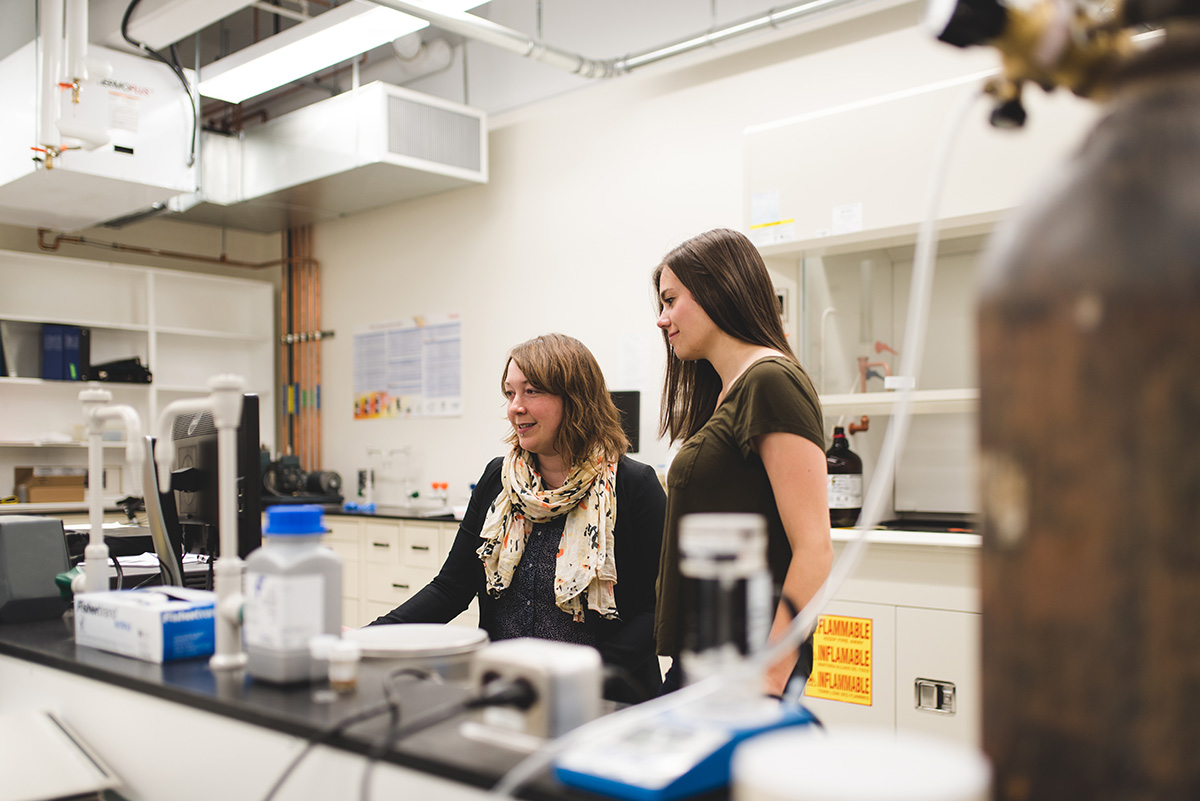
New alumna Stephanie Schneider (right) discovered her passion for environmental chemistry with Sarah Styler (left), assistant professor in the Department of Chemistry, whose research program focused on environmental chemistry. Credit: Dawn Graves
For new bachelor of science graduate Stephanie Schneider, an awareness of and passion for the environment has always been second nature. Now headed to the University of Toronto for graduate school in the field of environmental chemistry, Schneider reflects on how where it all began--at her family cabin on Wabamun Lake.
"I grew up spending my summers sailing and hiking and kayaking near Wabamun Lake," Schneider explains. "Ever since I was a kid, being outside and connected to nature has been important to me. We never had a motor boat or a jetski or anything like that. We just enjoyed the lake as it was."
Early inspiration
Ever curious, Schneider connected with the University of Alberta for the first time in high school, participating in the WISEST Summer Research Program in grade 11 and the TeamUP Science Interdisciplinary Science Competition in grade 12. So, when it came time to start her undergraduate degree at the University of Alberta, science was a natural choice.
"It wasn't a matter of choosing sciences so much as picking which science I wanted to focus on," she laughs. But after joining the honors chemistry program in her second year, Schneider was suddenly unsure.
"Things weren't coming together the way I thought they would. The courses were interesting, yes, but I didn't feel connected to my studies to that point. It felt like something was missing."
Relevant research
Enter Sarah Styler, newly-hired assistant professor in the Department of Chemistry, whose research program focused on environmental chemistry -- the perfect marriage between Schneider's love for science and her passion for the environment.
"Reading about Dr. Styler's research was inspiring because it was exactly what I wanted to do in my own career," says Schneider. "So, I applied for the Undergraduate Research Initiative in September 2015 and started doing research the following January."
Under the direction of Styler, Schneider has been investigating atmospheric dust and its impact on climate and air quality. Most recently, Schneider is studying the impact of the Fort McMurray wildfires in May 2016 by examining the ashes left behind. "We're trying to determine how the pollutants in the ash degrade when they are exposed to light--a process that takes place over time in all areas affected by the fire," she explains.
The project will continue after Schneider graduates from the honors chemistry program until she travels to Ontario to begin her graduate students in the same program her mentor Styler pursued. Eventually, Schneider hopes to pursue a PhD in environmental chemistry, an emerging and increasingly relevant field. But this summer, she's planning on kicking back at the lake.
Sage advice
As for what advice she'd impart on other aspiring female scientists, Schneider believes it's all about getting the experience.
"There are always programs out there that can help you. There is always a research course or an extracurricular activity or someone to talk to. Even if you don't end up doing it forever, even if you don't choose it or don't even like it, it's still an experience and you still learned from it."
But the first step, she says, is getting here. "Getting comfortable on campus is important. Past the undergraduate level, there are fewer women in science, fewer graduate students and fewer professors. Find someone or somewhere that makes you feel connected and excited. You belong here too."
Congratulations, Stephanie! And good luck with your graduate studies.